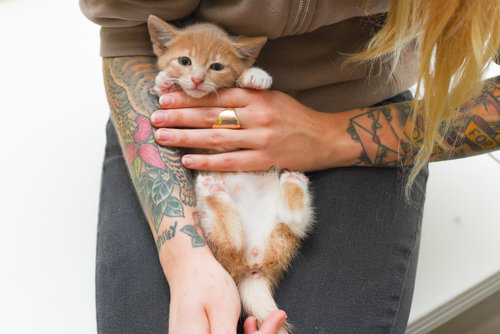Cacique & Nanichi: limping calici survivors!
Picture this: your kitten has always been healthy, happy, and playful…until suddenly one day you notice that she is limping. You wonder if she simply took a bad fall. But within mere hours, her limping worsens until she seems completely unable to use any of her limbs. She cannot put weight on her paws and collapses when placed on all fours. She is suddenly burning hot to the touch, trembling, and seemingly incapacitated.
She may have developed limping calici. While rare, this is an experience that some kitten foster parents and adopters will have, and it can be terrifying to go through without information about why it is happening and how to help.
What is limping calici?
Limping calici is a form of calicivirus, a viral infection in cats. While calici is mostly recognized for its symptoms of severe respiratory infection and painful oral ulcers, some kittens can become ill with a form of calicivirus that has no respiratory or oral symptoms at all. Limping calici is a form of the virus that causes sudden limping and lameness. While any cat can develop these symptoms, it is far more likely to occur in kittens due to their underdeveloped immune systems. It is also sometimes seen in recently FVRCP vaccinated kittens who are having a reaction to the vaccine.
What are the symptoms?
Symptoms of limping calici include sudden limping or weakness of one or all limbs, high fever, and trembling. Due to their inability to walk, the kitten may have secondary symptoms such as inappetence or inability to access food and water, bladder retention or inability to access a litter box, dehydration, and other secondary infections. These symptoms can last anywhere from 2 to 7 days, and most kittens can fully recover if given proper care and treatment. Without intervention, limping calici can be fatal, so you are advised to begin care as soon as symptoms arise.
What is the care for a kitten with limping calici?
If you believe your kitten has limping calici, it’s important to seek medical attention immediately. It is important to note that many veterinary providers will not have experience with limping calici, which makes it even more important for you to be a strong advocate for your kitten.
As with all viruses, there is no treatment for the infection itself, but symptom management is essential to survival. Proper care will include monitoring temperature and weight, providing subcutaneous or IV fluids, providing pain medication to ameliorate discomfort, and in some cases providing an anti-inflammatory medication that can help mitigate the fever and reduce joint inflammation caused by the virus. Some veterinarians may choose to prescribe an antibiotic to address any potential secondary infections, or an antiviral medication to boost the body’s immune response.
Care will likely also include supported feeding such as feeding a desirable food (try chicken flavored baby food) on a spoon, and assisting the kitten with accessing and using the litterbox. Hospitalization may be appropriate for foster parents who are unable to provide lifesaving skills such as fluid therapy, and any kitten with a fever of 105 or more should immediately be admitted for hospitalization. With care, most kittens should be expected to show signs of improvement within 48-72 hours.
How does a kitten develop limping calici, and how can it be prevented?
Calicivirus is highly contagious and can be contracted when the kitten either comes into direct contact with an infected cat, or comes into contact with an object such as hands, clothing, food bowls, blankets, or other objects that are contaminated. Once exposed to the virus, a kitten may start to develop symptoms within 2-6 days. They are contagious throughout the period of active illness, so it is important to quarantine them from other animals. If you know that you’ve been exposed to a cat with calicivirus, it’s important to wash hands and change clothing before coming into contact with other immunocompromised cats or kittens who can easily develop this virus.
Kittens can also develop these symptoms due to a vaccine reaction. If your kitten has recently received an FVRCP vaccine and has developed limping calici, it may be a reaction to the vaccine. These cases tend to resolve within 48-72 hours with the care detailed above. FVRCP vaccination is of essential importance for kittens in order to prevent dangerous and deadly viruses like panleukopenia. While reactions to the vaccine can happen, vaccination is always a net good and should be provided to every kitten. Simply speak with a veterinarian regarding any concerns, and monitor for any issues.





